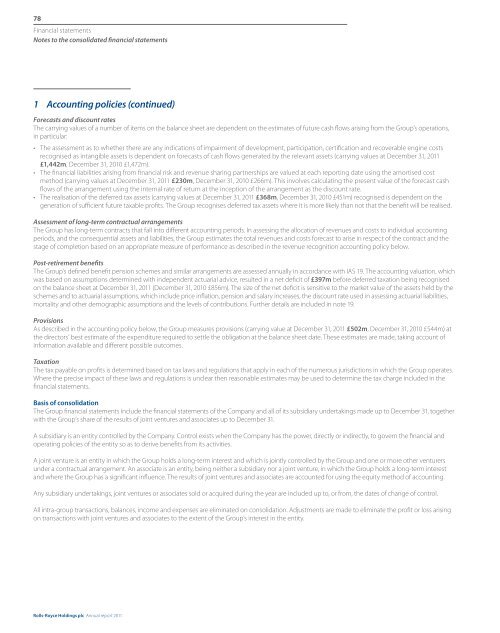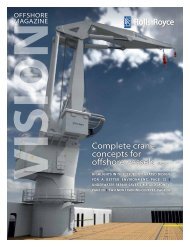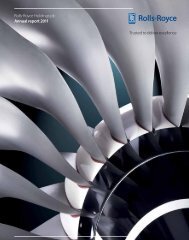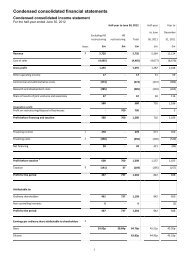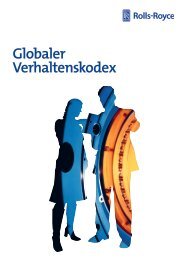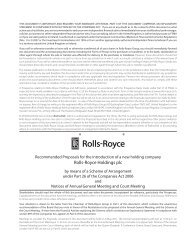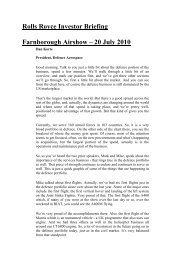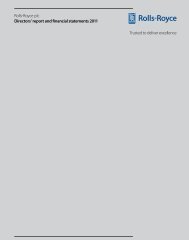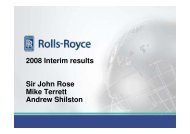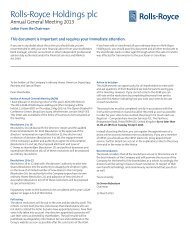Consolidated financial statements - Rolls-Royce
Consolidated financial statements - Rolls-Royce
Consolidated financial statements - Rolls-Royce
Create successful ePaper yourself
Turn your PDF publications into a flip-book with our unique Google optimized e-Paper software.
78<br />
Financial <strong>statements</strong><br />
Notes to the consolidated <strong>financial</strong> <strong>statements</strong><br />
1 Accounting policies (continued)<br />
Forecasts and discount rates<br />
The carrying values of a number of items on the balance sheet are dependent on the estimates of future cash flows arising from the Group’s operations,<br />
in particular:<br />
• The assessment as to whether there are any indications of impairment of development, participation, certification and recoverable engine costs<br />
recognised as intangible assets is dependent on forecasts of cash flows generated by the relevant assets (carrying values at December 31, 2011<br />
£1,442m, December 31, 2010 £1,472m).<br />
• The <strong>financial</strong> liabilities arising from <strong>financial</strong> risk and revenue sharing partnerships are valued at each reporting date using the amortised cost<br />
method (carrying values at December 31, 2011 £230m, December 31, 2010 £266m). This involves calculating the present value of the forecast cash<br />
flows of the arrangement using the internal rate of return at the inception of the arrangement as the discount rate.<br />
• The realisation of the deferred tax assets (carrying values at December 31, 2011 £368m, December 31, 2010 £451m) recognised is dependent on the<br />
generation of sufficient future taxable profits. The Group recognises deferred tax assets where it is more likely than not that the benefit will be realised.<br />
Assessment of long-term contractual arrangements<br />
The Group has long-term contracts that fall into different accounting periods. In assessing the allocation of revenues and costs to individual accounting<br />
periods, and the consequential assets and liabilities, the Group estimates the total revenues and costs forecast to arise in respect of the contract and the<br />
stage of completion based on an appropriate measure of performance as described in the revenue recognition accounting policy below.<br />
Post-retirement benefits<br />
The Group’s defined benefit pension schemes and similar arrangements are assessed annually in accordance with IAS 19. The accounting valuation, which<br />
was based on assumptions determined with independent actuarial advice, resulted in a net deficit of £397m before deferred taxation being recognised<br />
on the balance sheet at December 31, 2011 (December 31, 2010 £856m). The size of the net deficit is sensitive to the market value of the assets held by the<br />
schemes and to actuarial assumptions, which include price inflation, pension and salary increases, the discount rate used in assessing actuarial liabilities,<br />
mortality and other demographic assumptions and the levels of contributions. Further details are included in note 19.<br />
Provisions<br />
As described in the accounting policy below, the Group measures provisions (carrying value at December 31, 2011 £502m, December 31, 2010 £544m) at<br />
the directors’ best estimate of the expenditure required to settle the obligation at the balance sheet date. These estimates are made, taking account of<br />
information available and different possible outcomes.<br />
Taxation<br />
The tax payable on profits is determined based on tax laws and regulations that apply in each of the numerous jurisdictions in which the Group operates.<br />
Where the precise impact of these laws and regulations is unclear then reasonable estimates may be used to determine the tax charge included in the<br />
<strong>financial</strong> <strong>statements</strong>.<br />
Basis of consolidation<br />
The Group <strong>financial</strong> <strong>statements</strong> include the <strong>financial</strong> <strong>statements</strong> of the Company and all of its subsidiary undertakings made up to December 31, together<br />
with the Group’s share of the results of joint ventures and associates up to December 31.<br />
A subsidiary is an entity controlled by the Company. Control exists when the Company has the power, directly or indirectly, to govern the <strong>financial</strong> and<br />
operating policies of the entity so as to derive benefits from its activities.<br />
A joint venture is an entity in which the Group holds a long-term interest and which is jointly controlled by the Group and one or more other venturers<br />
under a contractual arrangement. An associate is an entity, being neither a subsidiary nor a joint venture, in which the Group holds a long-term interest<br />
and where the Group has a significant influence. The results of joint ventures and associates are accounted for using the equity method of accounting.<br />
Any subsidiary undertakings, joint ventures or associates sold or acquired during the year are included up to, or from, the dates of change of control.<br />
All intra-group transactions, balances, income and expenses are eliminated on consolidation. Adjustments are made to eliminate the profit or loss arising<br />
on transactions with joint ventures and associates to the extent of the Group’s interest in the entity.<br />
<strong>Rolls</strong>-<strong>Royce</strong> Holdings plc Annual report 2011


